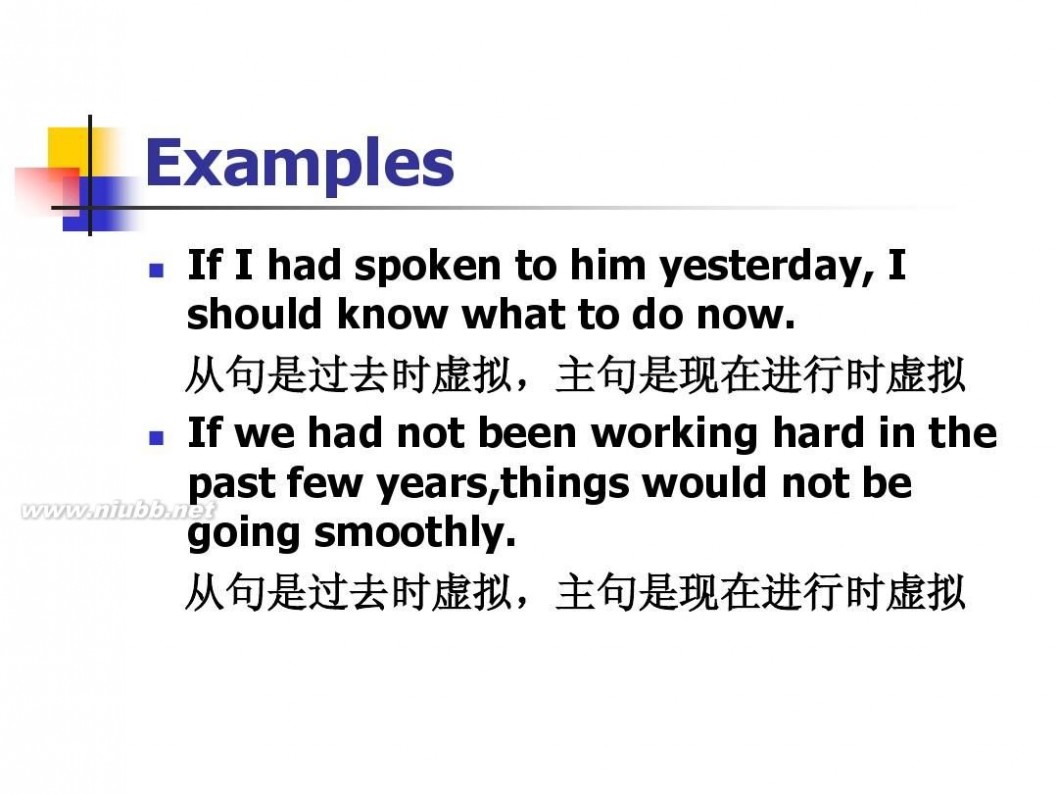一 : 虚拟语气讲解-updated

虚拟语气ppt 虚拟语气讲解-updated

虚拟语气ppt 虚拟语气讲解-updated

虚拟语气ppt 虚拟语气讲解-updated

虚拟语气ppt 虚拟语气讲解-updated

虚拟语气ppt 虚拟语气讲解-updated

虚拟语气ppt 虚拟语气讲解-updated

虚拟语气ppt 虚拟语气讲解-updated

虚拟语气ppt 虚拟语气讲解-updated

虚拟语气ppt 虚拟语气讲解-updated

虚拟语气ppt 虚拟语气讲解-updated

虚拟语气ppt 虚拟语气讲解-updated

虚拟语气ppt 虚拟语气讲解-updated

虚拟语气ppt 虚拟语气讲解-updated

虚拟语气ppt 虚拟语气讲解-updated

虚拟语气ppt 虚拟语气讲解-updated

虚拟语气ppt 虚拟语气讲解-updated

虚拟语气ppt 虚拟语气讲解-updated

虚拟语气ppt 虚拟语气讲解-updated

虚拟语气ppt 虚拟语气讲解-updated

虚拟语气ppt 虚拟语气讲解-updated

虚拟语气ppt 虚拟语气讲解-updated

虚拟语气ppt 虚拟语气讲解-updated

虚拟语气ppt 虚拟语气讲解-updated

虚拟语气ppt 虚拟语气讲解-updated

虚拟语气ppt 虚拟语气讲解-updated

虚拟语气ppt 虚拟语气讲解-updated

虚拟语气ppt 虚拟语气讲解-updated

虚拟语气ppt 虚拟语气讲解-updated

61阅读提醒您本文地址:
二 : 虚拟语气的用法和讲解用法和需要注意的细节,及怎样判断是否是虚拟语
虚拟语气的用法和讲解
用法和需要注意的细节,及怎样判断是否是虚拟语气.
一、虚拟语气表示一种不能实现的假设。该语法主要用于if条件状语从句。也可用于主语从句、表语从句、宾语从句等。
二、if条件状语从句中虚拟语气的判断
判断是真实条件句还是非真实条件句。只有在非真实条件句中才使用虚拟语气。通过句子意思,看假设的条件是否能够实现,能够实现是真实条件句,不能使用虚拟语气;假设的条件不能实现则是非真实条件句,要用虚拟语气。
判断这个假设是与哪个事实相反。通常有三种情况:①与过去事实相反。②与现在事实相反。③与将来事实可能相反。
三、“后退一步法”
后退一步法是指在准确地判断了该句与哪一事实相反后,按虚拟语气的后退一步法处理从句谓语动词的时态。即:在非真实条件状语从句中,谓语动词按正常情况“后退一步”。也就是:
①与过去事实相反,在从句中用过去完成时形式表示。
②与现在事实相反,在从句中用过去一般时形式表示。
③与将来事实可能相反,在从句中用过去将来时形式表示。
主句中则用情态动词would, should, could 等加一个与从句一致的动词形式。
例:If I had come her yesterday, I would have seen him.
If I were a teacher, I would be strict with my students.
If it should snow tomorrow, they couldn’t go out.
四、注意事项
①if条件句中如有were, should, had,可以省去if,并使用倒装语序。
②在现代英语中if条件状与从句中的谓语动词如果是be其过去形式一般用were。
一、wish 后面宾语从句中的虚拟语气
wish 后面宾语从句中的虚拟语气,按“后退一步法”处理从句的谓语动词。注意:与哪个事实相反,不能以主句的时态为判断依据,而是根据从句的意义判断。
二、表示“要求、建议、命令”等动词后面的宾语从句中的虚拟语气
从句中用“should + 动词原形”构成。而且should可以省去。用于此结构的动词有:advise, direct, agree, ask,
demand, decide, desire, insist, order, prefer, propose, request, suggest等。
注意:当insist表示“坚持认为”、suggest表示“表明,显示”时,不用虚拟语气。
The look on his face suggested that he was quite satisfied with what I had
done for him.
He insisted that he was honest.
三、would rather +从句
在这种结构中,从句的位于动词用过去形式表示虚拟。
I would rather you did this instead of me.
一、It be + 形容词 + that ...(should)...
用于该句型的形容词是:necessary, good, inportant, right, wrong, better, natural,
proper, funny, strange, surprising .
一些名词也可以用于 在该结构中。如:a pity, no wonder....
二、It be + 过去分词 + that ...(should)....
用于该结构中的过去分词是表示“建议、请求、命令”等词的过去分词。如:desired, suggested, requested,
ordered, proposed等。
三、It is time(about time, high time)that ...(过去式动词形式或should+动词原形)....
It is high time I went home now. = It is high time I should go home now.
在suggestion, proposal, order, plan, idea, advice,
decision等需要有内涵的名词后面的表语从句、同位语从句中,要使用虚拟语气。其谓语动词应用:should+原形动词。另外连接从句的that不能省略。
例:My suggestion is that weshould go there at once.
What do you think of his proposal that we should put on a play at the
English evening?
三 : 虚拟语气讲解

虚拟语气ppt 虚拟语气讲解

虚拟语气ppt 虚拟语气讲解

虚拟语气ppt 虚拟语气讲解

虚拟语气ppt 虚拟语气讲解

虚拟语气ppt 虚拟语气讲解

虚拟语气ppt 虚拟语气讲解

虚拟语气ppt 虚拟语气讲解

虚拟语气ppt 虚拟语气讲解

虚拟语气ppt 虚拟语气讲解

虚拟语气ppt 虚拟语气讲解

虚拟语气ppt 虚拟语气讲解

虚拟语气ppt 虚拟语气讲解

虚拟语气ppt 虚拟语气讲解

虚拟语气ppt 虚拟语气讲解

虚拟语气ppt 虚拟语气讲解

虚拟语气ppt 虚拟语气讲解

虚拟语气ppt 虚拟语气讲解

虚拟语气ppt 虚拟语气讲解

虚拟语气ppt 虚拟语气讲解

虚拟语气ppt 虚拟语气讲解

虚拟语气ppt 虚拟语气讲解

虚拟语气ppt 虚拟语气讲解

虚拟语气ppt 虚拟语气讲解

虚拟语气ppt 虚拟语气讲解

虚拟语气ppt 虚拟语气讲解

虚拟语气ppt 虚拟语气讲解

虚拟语气ppt 虚拟语气讲解

虚拟语气ppt 虚拟语气讲解

虚拟语气ppt 虚拟语气讲解

61阅读提醒您本文地址:
四 : 详细的虚拟语气讲解资料,四六级绝对有用
虚拟语气绝对是令很多人感到头痛的一个语法点。这是我从网上和一些语法书上收集整理而成的一份学习资料,希望对你有用。如果觉得好,支持一下,便是给我的最大鼓励。
虚拟语气
第一部分:语气的定义和种类
1 语气(mood)
语气是动词的一种形式,表示说话人对某一行为或事情的看法和态度。
2 语气的种类
⑴、陈述语气:表示动作或状态是现实的、确定的或符合事实的,用于陈述句、疑问句和某些感叹句。如:
①there are two sides to every question.每个问题都有两个方面。
②were you busy all day yesterday?昨天一整天你都很忙吗?
③how good a teacher she is!她是多好的一位老师啊!
⑵、祈使语气:表示说话人对对方的请求或命令。如:
①never be late again!再也不要迟到了。
②don’t forget to turn off the light.别忘了关灯。
⑶、虚拟语气:表示动作或状态不是客观存在的事实,而是说话人的主观愿望、假设或推测等。如:
①if i were a bird, i could fly in the air.如果我是一只小鸟,我就能在空中飞行。
②i wish i could pass the examination.我希望我能通过考试。
③may you succeed!祝您成功!
虚拟语气在语法里算得上是个难点。让我们就从最简单的开始吧。
第二部分:简单句中的虚拟语气
一、情态动词的过去式用于现在时态时,表示说话人的谦虚、客气、有礼貌、或委婉的语气,常用于日常会话中。如:
⑴.would you be kind enough to show me the way to the post office?请你告诉我去邮局的路好吗?
⑵.it would be better for you not to stay up too late.你最好别熬夜到很晚。
二、表祝愿。
1、常用“may+动词原形”表示祝愿,但愿,此时may须置于句首(多用于正式文体中)。
⑴、may good luck be yours!祝你好运!
⑵、may you be happy!祝你快乐!
⑶、may you do even better!祝你取得更大成就!
⑷、may you have a good time. 祝愿你玩的痛快。
⑸、may the friendship between us last long. 祝愿我们的友情天长地久。
⑹、may you be happy. (注意那个be ) 祝你幸福。
2、用动词原形。例如:
(1).long live the people! 人民万岁!
(2).“god bless you,”said the priest.牧师说:“愿上帝保佑你!”
(3).have a good journey! 祝愿你旅途愉快!
三、表示强烈愿望。(该类型虚拟语气谓语仅用动词原形,第三人称单数也不加“s”)
(1).god save me.
(2).heaven help us.
四、表命令
1.命令虚拟语气只能用在第二人称(you),而且通常省略主语(也就是you)。
2.句子尾通常加上感叹号:!
3.虚拟语气动词用一般现在时态(simple present),如:work, be , go
4.否定形式的命令语气,可用助动词do,加上not。
(1). work !
(2). work harder !
(3). be more alert ! (虚拟语气动词be)
(4). you go out !
(5). do not work so hard. (do not 表示否定的虚拟语气)
(6). don't be afraid. (口语中常用don't 代替do not)
五、在一些习惯表达中。如:
(1).you’d better set off now.你最好现在就出发。
(2).i’d rather not tell you the secret.我情愿不告诉你这个秘密。
本文标题:虚拟语气讲解-虚拟语气讲解-updated61阅读| 精彩专题| 最新文章| 热门文章| 苏ICP备13036349号-1